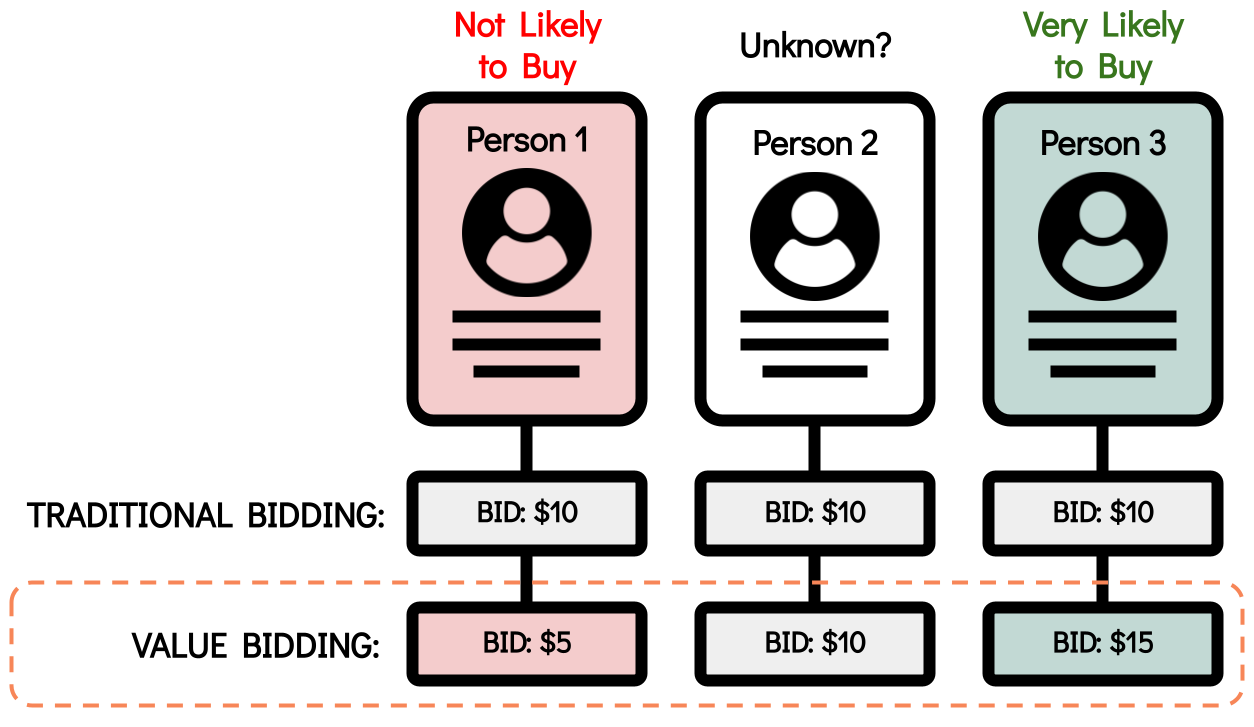How B2B Brands Can Improve Lead Quality with Bid-to-Value
Bid-to-Value (also known as “value based bidding” in the context of paid search) is a bid strategy that uses AI to adjust the amount you are willing to pay for a click based on the probability that the customer will be valuable to your business. In this article I will explain how bid-to-value works, and how DiveTeam uses a three-step process to help B2B brands apply this strategy to improve lead quality.
How Bid-to-Value Works
Let’s imagine that you work for a tech company that sells HR software, and you are using Google Ads to drive prospects to submit a lead on your website. When you use a traditional bidding strategy you will offer to pay the same amount for each click, despite the fact that there might be a lot of people searching Google for your keywords who would never purchase your product – maybe they are not in the market right now, they do not have the authority to make a purchase decision, or they are just a bot.
When you enable a bid-to-value strategy, Google Ads will begin training a look-alike model to determine how similar each user who might view your ad is to those users who are purchasing your HR software. When the model determines that a user is similar to other users who purchase your software (person 3 in the image below) it will increase the amount you are willing to bid for the click. Conversely, when the model determines that a user is similar to those who are not likely to purchase your software (person 1) it will decrease the amount you are willing to bid for the click.
If the model is working properly your HR company will receive higher quality leads from your paid search campaigns because more of your budget will be spent targeting ads to valuable customers, and less will be wasted on those users who are not likely to convert. How much higher quality? Well that depends on the data that you send back to Google to train the look-alike model, and this can be a challenge for B2B brands.
Why B2B Brands Struggle to Send Sufficient Data for Bid-to-Value
Bid-to-value strategies attempt to maximize the value of your conversions rather than the volume of conversions, and so they rely on you to send some type of value score back to the ad platform that represents how valuable a user was after they clicked your ad. This is relatively simple for retail brands that track online transactions, because they can simply fire a conversion event with the transaction value whenever an online purchase is complete (according to Google’s internal data, bid-to-value strategies increase conversion values by an average of 14%), but it can be a challenge for B2B brands who drive users to submit a lead form.
Most B2B brands only send a small number of conversion events back to Google Ads after the initial click. For example, a brand with a 9% conversion rate on the lead form will track a conversion for 90 users out of every 1,000 who click on their ads. But B2B companies often have months-long sales cycles, and they will not know the value of those leads until the deal is won or lost.
As a result, most B2B brands do not send any value score back to Google Ads, and those that do are typically sending this data back 3 to 6 months after the click (using the offline conversions sync with their CMS), which is too slow to train a look-alike model!
To solve this data problem, B2B brands need to address three challenges:
Volume - Scores should be sent for as many users as possible.
Variance - Scores should have as much variance as possible (it’s not enough to send a “100” for everyone who converts) so the model can recognize both “good” and “bad” customers.
Velocity - Scores should be sent as quickly as possible after the ad click (do not wait for the deal to close)
At DiveTeam we have developed a unique approach to address this problem!
DiveTeam’s 3-Step Approach to Bid-to-Value for B2B
Our approach to improving B2B lead quality with bid-to-value follows these steps:
Step 1: |
Use your best judgment to increment a user's score as they complete micro-conversions. |
|---|---|
Step 2: |
Train a model to algorithmically identify which micro-conversions are correlated with users who go on to become qualified leads. |
Step 3: |
Train a new model to score the probability that each user will become a qualified lead in the future, and pass the score as an offline conversion value. |
Define Your Objective
All of the solutions that we design at DiveTeam follow the four principles of Modern Marketing, and the first of these principles is outcome based measurement strategy. This means that before any work begins we work with you to determine what our desired outcome is and how we will know if we are successfully achieving that outcome. In a bid-to-value project we want to improve lead quality, but since this can be difficult to measure we might choose a few proxy metrics that can be used for A/B testing. Once we are aligned on the measurement strategy we are ready to dive into step 1.
STEP 1: Deploy a Heuristic Model
We use our best judgment to identify the important actions that a prospect might take on your website or mobile app before submitting a lead as a starting point. Then we make sure that these events are properly tracked in Google Analytics (the free version is fine) and any other tools that you are using to track conversions (Google Ads, Meta, etc.).
To prepare for step 2 below, we will also enable the free integration between Google Analytics and BigQuery so that we can begin collecting your raw event data. Lastly, we will update your lead forms to integrate Google Analytics with your CRM system if this has not been done already.
Next, we create a point system that scores the important actions or micro conversions that users might take on your website as they consider purchasing your product. For example:
View product details page = 10 points
Play the promotional video = 25 points
Sign up for an email newsletter = 20 points
Etc.
Lastly, we update your tag manager to track each of these conversions and pass the points into your ad platforms as conversion values.
To validate the heuristic model we wait about 2-4 weeks for Google to train a look-alike model. Then we will work with you or your agency to run an A/B test to confirm that the bid-to-value strategy using the heuristic model is improving your lead quality above the prior bid strategy.
This will run until we have collected sufficient data to move on to step 2.
STEP 2: Tune the Heuristic Model with a High Value Action Analysis
We have found that we can move into step 2 once you have collected at least 150-200 users with conversions in BigQuery. In this step we can use your raw data to conduct a high value action analysis, which tells you which user actions are correlated with future conversions. This allows you to replace the heuristic model created in step 1 with a new scoring system that has been generated algorithmically.
With the results of the high value action analysis in hand, our team will update your tracking code one more time to pass the new conversion values. We will then wait 2-4 weeks for Google to train a new look-alike model before running a second A/B test to measure how well the new look-alike model is performing above the heuristic model created in step 1.
STEP 3: Deploy a Propensity Model
Step 3 is significantly more sophisticated than step 2. This is because it requires a higher lead volume, and you will need to continually transfer and blend data between your analytics, CRM and advertising tools. Luckily, that’s what we do best, and we’ve built software to make it quick and easy to roll this out for our clients!
Before we begin step 3 we will need to flag the users who have also been identified as qualified leads by your sales team. Similar to step 2, will need to flag at least 150-200 profiles before attempting to train a model.
The propensity model works by observing each user’s behavior for 7 days after they click on your ad (this is known as the evaluation window and it can be adjusted if it makes sense for your sales cycle). It will then create a profile for each user with attributes such as:
Sample user profile for propensity training
This data will be used to train a model that scores the probability that each user will be flagged by the sales team as a qualified lead in the future based on the behavior that they exhibited during the evaluation window. Once your model is trained, it will be scheduled to run daily to generate scores for the users who clicked your ad 7 days ago (before the evaluation period) and then upload the scores back into your advertising tools as conversion values.
The Result
Volume - When the propensity model is in place and running daily, 100% of users who click on your ads will receive a score.
Variance - Scores will be a range between 0 to 100 that reflects the probability that this user will become a qualified lead in the future.
Velocity - Scores will be uploaded 8 days after the click (or whenever the evaluation window closes) to provide rapid feedback on the value of each user, even if the sale is not completed for another 6 months!
Finally, after the model has been in place for 2-4 weeks we will run another A/B test to ensure the propensity model is outperforming the prior models that we created in steps 1 and 2.
Ready to Give it a Try?
This might sounds like a lot of work, but when you work with DiveTeam we focus on taking small steps, showing value quickly, and making iterative improvements. Most of the time required to complete this project is spent waiting for data to come in, and we have built the software to make it quick and easy to train/deploy the necessary models for propensity and high value action. We have found that it takes about 6-9 months for a B2B brand to fully deploy this strategy and validate that it has improved the quality of leads that they are receiving.
We would love to schedule 30 minutes with you to tell you more about our process and the results we have seen with other clients!





